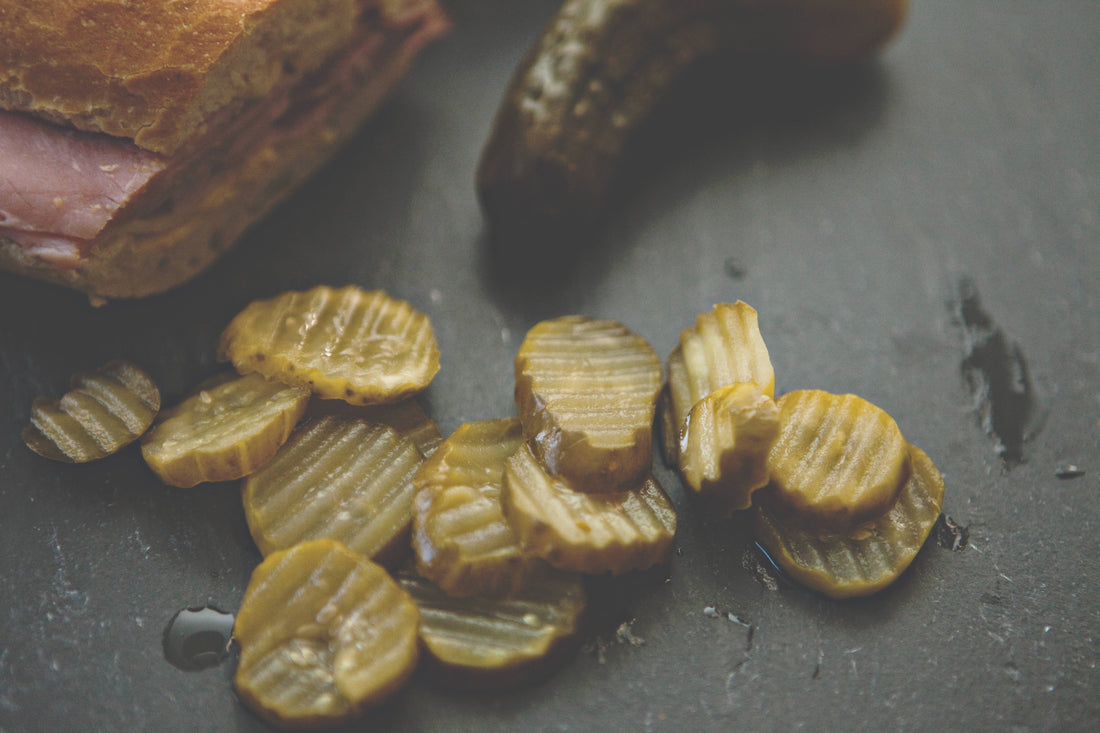
The Origin of Trü Pickles
Share
Many people ask us about how we got started. The gist of the story is on our jar of Original Dills –
In the 1900s, many immigrants from all parts of the world came to the United States, bringing with them family recipes to use in the New Country. Greg Skufca’s great-grandmothers were no different. One brought with her the recipe for bootleg liquor and even built a still in her kitchen (that’s a story for another time). The other great-grandmother brought all her canning knowledge with her.

Most recipes weren’t written down; they were passed on through hands-on example... from Greg’s grandmother to his father, and ultimately to him. But Greg did one thing differently—he wrote down the recipes, measurements, and process. Greg would grow all his own produce and can what he could for friends and family, and one item always stood out: the pickles.
After 25 years in the business world, Greg needed something more. That’s when he decided it was time for more people to taste his pickles.
Greg did indeed grow all of his own cucumbers and the spices he used in his recipes. He’d spend his summers canning his pickles and then handing them out to friends, family and coworkers. We all really did love his pickles and looked forward to getting them every year, and making our jars last. We often joked with him about how he should sell them, they were so good. Perhaps one remarkable testimony was when my four-year-old, who hated pickles as a rule, finally screwed up her guts to try one, and then was begging him for them for her birthday. That’s when I thought, “Seriously, if these pickles can turn this child into a pickle freak, then he really DOES need to sell them!”

Pretty soon we started talking more seriously about how to actually sell pickles. Greg always likes a challenge, and really started to embrace this idea. It started as a hobby, just learning more about how to produce pickles on a larger scale, how to create a label, how to have a product label approved, how to have nutritional contents verified ….. all those fun things. One of the first challenges was trying to figure out how to produce the pickles and still have them taste like Grandma’s. It’s one thing to can them in your kitchen on a small scale, and completely different trying to produce them in larger quantities. Greg researched co-packers, talked to lots of people, and once we found someone who could help us out by using their excess capacity, that took us to the next step. Grandma’s recipe is not a difficult one, but it IS a “secret” one, and therefore we had to make sure we had a non-disclosure agreement in place. We fresh pack the pickles, meaning all of the cucumbers go in fresh, along with the garlic, dill, pepper, and then the brine is poured over it, and the jars brought up to the proper temperature. This make them crunchier, fresher tasting. We did not want to make pickles that sat in vats. Being fresh-packed was a must for us, because that’s how Grandma did it. We had to make sure that the copacker could produce our pickles as fresh-packed, that they could use just the natural ingredients Greg used in Grandma’s recipe, and then ….. it was figuring out the quantities of ingredients on a larger scale. You might think that if you make this many gallons with these measurements of ingredients, then you could just multiply that by 50 times if you wanted to make 50 times as many jars. That actually isn’t true. Certain ingredients do not scale in that way. So we had to play with the recipe. In fact, it took us over 8 months to get the ingredients right. A fresh packed jar of pickles has to sit for three weeks to “cure”, so once we had a recipe to try, we had to wait three weeks to find out if it was right. If it wasn’t, we had to tweak it and then wait another three weeks ….. it was quite the process, but we were absolutely determined that it HAD to taste just like Grandma’s, or there was no point. No settling for “almost like Grandma’s”. We were not in a hurry – this was just a hobby after all, not our full time job and not putting food on the table for our families (other than some jars of pickles!). Finally, we had the recipe just right. Boy, were we excited!

As we waited to get the recipe right, we had to figure out a name. What to call these pickles ….. Greg asked himself, “What are these pickles? What makes them different, unique? What is important about them?” He woke up in the middle of the night one night, thinking about how these pickles are truly natural, truly crisp, true to Grandma’s recipe and traditions, true ingredients, nothing artificial …. A True Pickle. But then he also started playing with the Austrian origin of his family, and spelling True with umlauts – Trü. The umlauts can generally signify a vowel mutation (such as when goose becomes geese, mouse becomes mice, for the plural forms of these words), and it made Greg think of truth in plural, “many truths” in our pickles. Don’t question it more than that – and literary scholars, please don’t take us to task on our incorrect interpretation of the umlaut; this was, after all, a 2am thought in Greg’s head, not serious research (insert smile face). So, we had a name. Trü Pickles.
Next we had to come up with a label. How did we want our label to look? Greg went to the grocery store and looked up and down pickle aisles, noticing what stood out, what didn’t, and how could we change the look to stand out? We decided that while this recipe was Grandma’s, we did NOT want a “Grandma” label. There were plenty of those. Nothing cutesy, no white-haired, sweet-looking old lady, nothing old school, we wanted something that looked as fresh and crisp as our pickles. It’s an Old World recipe, but we wanted a New World look. So we started playing with ideas. Greg has a friend who does graphic design, and he brainstormed with us and started creating some versions, and we kept playing around with colors and layouts and designs, till we have the label we have today. It is different, it stands out. Greg took a prototype with him to the store, went to the pickle aisle, put his label around a jar and stood back to see how it looked. It really stood out, it drew the eye, it did not look like other pickles in the aisle. We were happy, we felt we finally had something to work with! Keep in mind, this all took us about a year. Just some tossing around of ideas between the hours of our day jobs, a fun side hobby.
So ….. we ran a pallet of 720 jars. When those jars showed up, I think our eyes may have bulged a bit as we asked ourselves, “Oh boy, now what?? How are we going to get rid of all of these?!” Luckily, Greg is a people-person (I like to stay behind the scenes, with a calculator and numbers and written words, Greg likes to be out talking to people and meeting people). We jokingly refer to Greg as the bull in the china shop, and I run after him with a broom! Greg just started going out and taking jars of pickles to people. Not just grocery stores, but to anyone who has customers that wait in line or in a chair. A tire store, a hair salon, a car wash … who said only grocery stores can sell pickles? We decided that our pickles would be one of many in grocery, but could be the ONLY pickle in so many other places! This attitude is really what contributed to our success. We had many store owners and managers tell us, “We can’t sell pickles here, no one will buy pickles in my (tire store, hair salon, hardware store),” and Greg would say, “Just put them on your counter, if you don’t sell them, I’ll come back and get them. You have nothing to lose.” It was true (or should I say Trü) – people DID buy them. Often we’d hear stories like, “Why do you sell pickles here?” as they pick up a jar and decide to try one, because after all, if a tire store is selling pickles, they HAVE to be good, or they wouldn’t be there, right?? We started having a lot of success locally, and moving that pallet wasn’t as hard as we thought. In fact, word of mouth between store owners was spreading and we were doubling and tripling the number of stores we picked up. Next thing we knew, we went to our first Ace Hardware trade show and our nationwide distribution began. That’s another story in itself, but within about 8 months of peddling our first jars of pickles, we were able to get our pickles to people all over the United States (and even Micronesia, who would ever have guessed that??), and it is still humbling for us to think about. We have all of you to thank, for trying our products and spreading the word.


The best thing is that it was a LOT of fun. Watching this hobby turn into an actual business was amazing. We refer to it as our baby, and we watched our baby grow with the same pride and joy as any parent. We would demo our products at some local events, and we actually had people start to cry at our booth – scared me at first, I’m handing a lady a tissue and thinking, “What is wrong? What did we do??” But people would say things like, “These pickles taste just like my Grandma’s!”, or “I haven’t tasted a pickle like this since I was a small child in my mother’s kitchen,” and people were really moved and touched in ways we really did not expect. It was (and still is) the most satisfying thing about what we’ve done. Watching stores have fun with our products, and customers having fun with it, and knowing that people out there are madly in love with a product WE created … it’s just a really great feeling.

We have since gone nationwide, with several products now, and we get to travel and talk to people all over the country who share these same stories about the memories they have of their grandmas, mothers, aunts who used to can their own pickles. We never would have guessed that pickles could have such a vivid impact on people. But then again, they DID turn a pickle-hating 4-year-old into a self-proclaimed Trü Pickle Princess! In fact, that four-year-old is now a 13-year-old who has helped at tasting events, has sold pickles outside the office to raise money, and drinks the juice in her water bottle while training as a 2nd degree black belt. I guess that IS a pretty powerful pickle!
-
Nikki Baird
